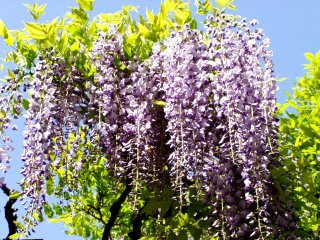Fuji and Purple
 Fuji - Wisteria
Fuji - Wisteria- Member of the pea family with vines growing up to 25ft. Large purple flowers bloom around April in clusters.
- During the Heian period, wisteria wounding around a pine tree was considered as an aesthetic.
- Produces flat, non-ornamental pea pods that are poisonous
- Wisteria was a symbol of power in the Heian Period for two reasons. Firstly, the name Fujiwara (Heian's powerful clan) comes from this flower. Secondly, the vines were used as ropes in the fields for transportation and constructing buildings.
- Japanese wisteria is one of the most highly romanticized garden plant and used traditionally for bonsai. The reason for this is thought to lie in the color purple.
- Purple stood for royalty and high class in the Heian period. Therefore, only the emperor/empress and higher aristocracy were allowed to wear purple robes.
In Relation to Genji - Fujitsubo and the Color Purple
- Fujitsubo is highly romanticized as Genji's first and ideal love, just as the flower is praised in the gardens.
- She is also a powerful, significant figure in the tale much similar to why wisterias were a powerful symbol. Firstly, she was married off to the Emperor by her family, similar to how the Fujiwara clan married their daughters off to establish strong relations with the royal family. Secondly, she moves Genji's heart and his ideal woman is constructed out of her beauty (i.e. Murasaki looks identical to Fujitsubo)
- Wisteria means both elegant and unattainable (Japanese: "blown by the wind") beauty (花言葉). This can be applied to Fujitsubo's beauty and how Genji is never able to have her as a wife by his side.
- Another purple flower! As Genji's first love, she holds the significant color purple, which can stand for intimate and passionate relationships. So far, Fujitsubo, Kiritsubo, Murasaki and Aoi all have an important role as Genji's ladies and purple flowers.
- In the heian court, 5 pavilions (tsubos) were made. One was named after thunder (raimeitsubo), but the other 4 were named after plants: pear (nashitsubo), plum (umetsubo), paulownia (kiritsubo) and wisteria (fujitsubo). The pear and plum flowers are usually white and the paulownia and wisteria flowers are purple. By making Genji's ideal lady Fujitsubo, and not the pear or plum, signifies the strong connection to purple.
- Murasaki Shikibu's real name is unknown, but her lady-in-waiting name for the Fujiwara family was Fuji Shikibu!!! (source: Wikipedia Japan)Therefore, Fujitsubo can signify her earlier name and how Genji loved her first. Shikibu changing her name to Murasaki, can signify how Genji found another love. The significance of purple may have come from this connection. In a sense, Shikibu might have been slightly self-centered as both of Genji's true love comes from her names.

1 Comments:
At 7:22 PM, Ann Wilson said…
Ann Wilson said…
Couple things of interest here! Interesting how the plant is poisionous and unattainable
also the stuff about the authors name. Glad you blogged this!
Post a Comment
<< Home